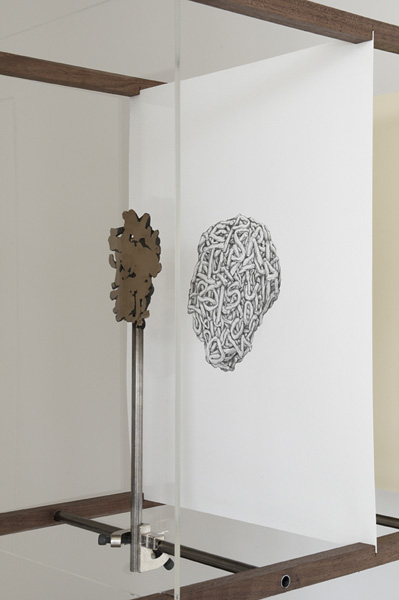On Unknown Devices Colin Perry, 2010
When operated, the device dismantles everything around it into their constituent parts. The effect is not unlike a technical manual for a car engine. Unlike in a diagram, however, the objects here are re-arranged into three-dimensional space. Unfortunately, the device is more than the enthusiastic amateur had bargained for: rather than simply observing ob- jects, it reconfigures them physically. The scientist’s brain is transformed into a drawing of a ball of letters. His black cat (perhaps it was a dog or a goldfish) is reconfigured into a pair of sculpted hands. Even the device itself is transformed. It has become a three-dimensional illustration of its own functionality: previously, it was a single mechanical box; now, it is now tessellated outwards into space.
We spoke about various connections: Bunsen burners, box cameras and accordions. The artist mentioned the importance of certain words (‘extruded’, ‘incompleteness’). He spoke about Brunelleschi’s single-point perspective (only one of many competing Renaissance theories; there were also double- and triple-point perspectives). We agreed that scientific demonstrations had a sort of candour about them (is everything else dishonesty?). The artist told me about levels of reality, hermits, lampshades, studio-based experimenta- tion, casting methods for bronze, and the idea of incompleteness. He had a photograph of a sculpted ear he’d snapped on a recent visit to the British Museum. It was unearthed from a site in Egypt, and had been designed either to allow mummified Pharaohs to communicate with the living or to encourage the gods to listen to lay folk (were their gods a little deaf?).
Position: head-height, eye-height, shoulder-height, etc.
Arrangement: in a line, as if emitted from a single source, but then looping back, as if in contra-flow or feedback. Proportions: diminishing or expanding, like waves or pulses of energy.
The object is composed of a hardwood frame, various elements of finely cast plaster mixed with powdered graphite, a drawing or two, and one or more glass panes. By appearances, it might be an object built by nineteenth-century hands. By this, I mean that a modern scientist would use plastic, batteries or mains electricity, and none of these are present here. Another strange thing about this object is that it is impossible to tell what its purpose is, despite the fact that it clearly looks designed for some specific task. Because it looks technically old-fashioned, its purpose might also be anachronistic. Perhaps it was designed to record levels of some substance that we might today assume to be immeasurable or non-existent (aether, or the electrical presence of ghosts).
A scientist, who is really more of an enthusiast than a professional man of science, has installed the device in the parlour of a country house. The heavy velvet drapery has been removed and the floorboards are bare and dusty. He calls the object of these experiments ‘The Real’, which he writes in upper caps in his notebook, because he thinks his studies are of paramount importance, and also because anything in upper caps has an air of solidity to it. His theory is this: one part of the spectrum of ‘The Real’ is two-dimensional, and it is where images dwell. There is a part assigned to three-, and four- dimensionality, where spherical, orthogonal, and time-based things exist. Another part of the spectrum is where Emotions, Mind, Spirits, and (perhaps) God, exist. These things can all be confirmed, measured or recorded by the device.


The Projectionist’s Shadow (Another Anecdote About Edges)
2010
cast jesmonite with graphite, pencil on paper, wood, MDF mirrired perspex, steel, clamps
153 x 40 x 174 cm

The Projectionist’s Shadow (Another Anecdote About Edges) (detail)
2010
cast jesmonite with graphite, pencil on paper, wood, MDF mirrired perspex, steel, clamps
153 x 40 x 174 cm

The Offer Up
2010
cast jesmonite with graphite, pencil on paper, wood, MDF mirrired perspex, steel, clamps
187 x 106.5 x 37 cm

The Back Of The Front
2010
bronze, pencil on paper, mount board, MDF, perspex, wood, steel, clamps
188.5 x 156 x 38 cm

The Back Of The Front (detail)
2010
bronze, pencil on paper, mount board, MDF, perspex, wood, steel, clamps
188.5 x 156 x 38 cm

The Back Of The Front (detail)
2010
bronze, pencil on paper, mount board, MDF, perspex, wood, steel, clamps
188.5 x 156 x 38 cm


The Projectionist’s Shadow (Another Anecdote About Edges) (detail)
2010
cast jesmonite with graphite, pencil on paper, wood, MDF mirrired perspex, steel, clamps
153 x 40 x 174 cm

The Offer Up
2010
cast jesmonite with graphite, pencil on paper, wood, MDF mirrired perspex, steel, clamps
187 x 106.5 x 37 cm